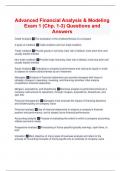Exam (elaborations)
Advanced Financial Analysis & Modeling Exam 1 (Chp. 1-3) Questions and Answers
- Course
- Institution
Credit Analysis The evaluation of the creditworthiness of a company 2 types of creditors Trade creditors and non trade creditors Trade creditors Provide goods or services, bear risk of default, most short term and usually implicit interest Non-trade creditors Provide major financing, bear risk o...
[Show more]



